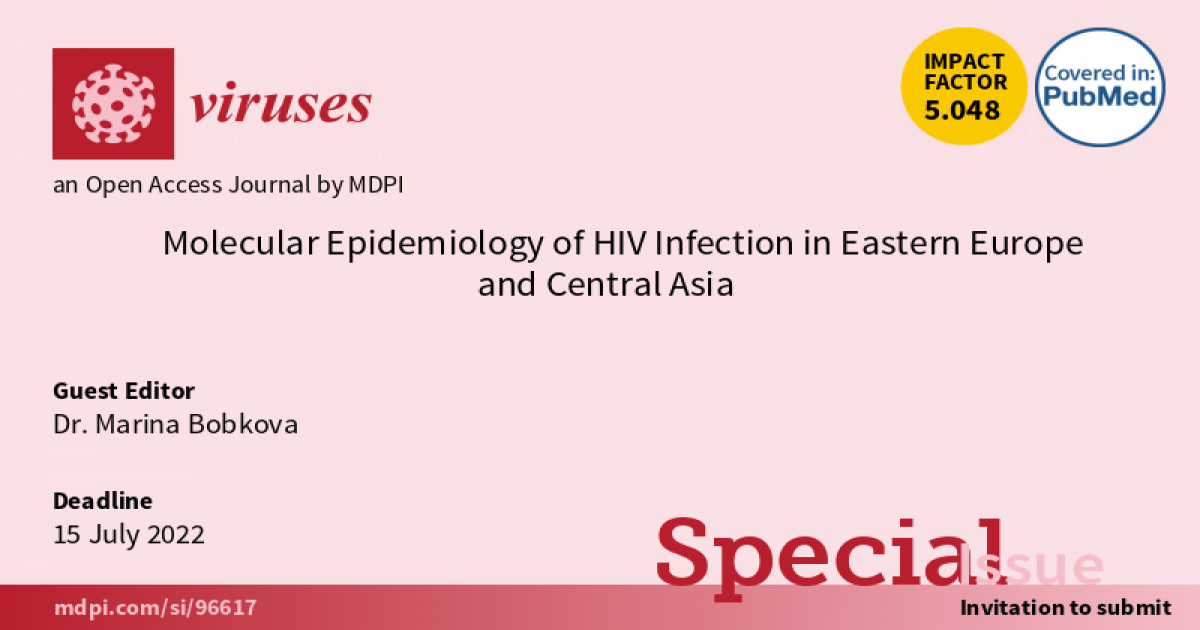Molecular Epidemiology of HIV Infection in Eastern Europe and Central Asia
A special issue of Viruses (ISSN 1999-4915). This special issue belongs to the section "Human Virology and Viral Diseases".
Deadline for manuscript submissions: closed (15 July 2022) | Viewed by 12777

Special Issue Editor
Special Issue Information
Dear Colleagues,
The HIV epidemic began in Eastern Europe and Central Asia (EECA) somewhat later than in Western countries, but the spread of infection was much faster. The incidence rate in the region continues to be the highest in the world today. This is largely explained by the features of the epidemic, which was determined by the virus transmission among intravenous drug users in the first decade of the epidemic.
Over the years of the epidemic, many studies have been carried out regarding the spread of HIV subtypes in Russia and other countries. Over time, the tendency towards the dominance of the A6 sub-subtype gradually changed, and at present there is an increase in the prevalence of other genetic variants of HIV, including recombinant forms, as well as a tendency to the formation of double recombinants. These data are very important for the strategies of HIV infection diagnosis and treatment both in the EECA countries and worldwide.
This Special Issue will focus on the molecular epidemiology of HIV infection in the EECA region, and highlight current trends in HIV diversity in these countries. We welcome original research and reviews related to the prevalence of HIV genetic variants in the EECA region, with emphasis on HIV recombinants, drug resistance, transmission networks and virus evolution. Consideration of the role of HIV genome polymorphism in antiretroviral therapy effectiveness is also of high interest.
Dr. Marina Bobkova
Guest Editor
Manuscript Submission Information
Manuscripts should be submitted online at www.mdpi.com by registering and logging in to this website. Once you are registered, click here to go to the submission form. Manuscripts can be submitted until the deadline. All submissions that pass pre-check are peer-reviewed. Accepted papers will be published continuously in the journal (as soon as accepted) and will be listed together on the special issue website. Research articles, review articles as well as short communications are invited. For planned papers, a title and short abstract (about 100 words) can be sent to the Editorial Office for announcement on this website.
Submitted manuscripts should not have been published previously, nor be under consideration for publication elsewhere (except conference proceedings papers). All manuscripts are thoroughly refereed through a single-blind peer-review process. A guide for authors and other relevant information for submission of manuscripts is available on the Instructions for Authors page. Viruses is an international peer-reviewed open access monthly journal published by MDPI.
Please visit the Instructions for Authors page before submitting a manuscript. The Article Processing Charge (APC) for publication in this open access journal is 2600 CHF (Swiss Francs). Submitted papers should be well formatted and use good English. Authors may use MDPI's English editing service prior to publication or during author revisions.
Benefits of Publishing in a Special Issue
- Ease of navigation: Grouping papers by topic helps scholars navigate broad scope journals more efficiently.
- Greater discoverability: Special Issues support the reach and impact of scientific research. Articles in Special Issues are more discoverable and cited more frequently.
- Expansion of research network: Special Issues facilitate connections among authors, fostering scientific collaborations.
- External promotion: Articles in Special Issues are often promoted through the journal's social media, increasing their visibility.
- e-Book format: Special Issues with more than 10 articles can be published as dedicated e-books, ensuring wide and rapid dissemination.
Further information on MDPI's Special Issue polices can be found here.






